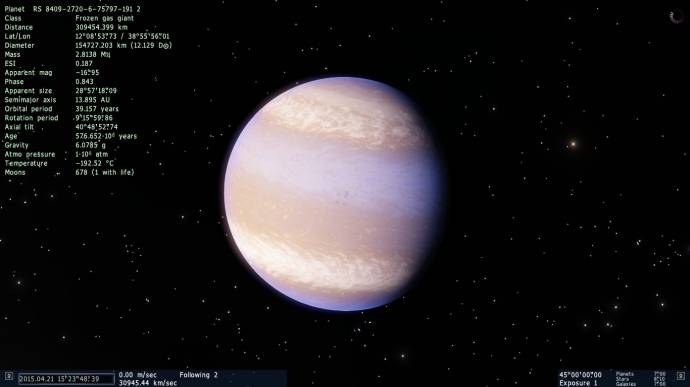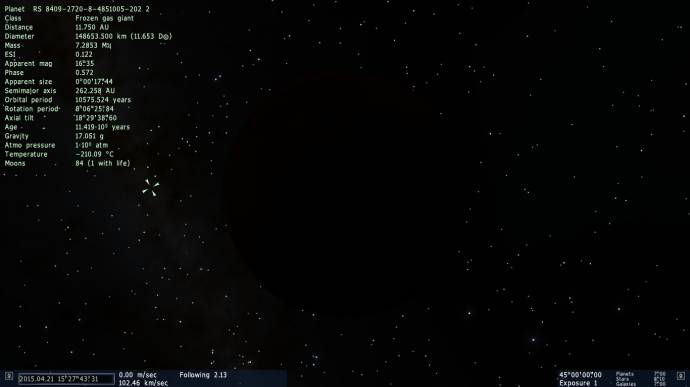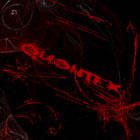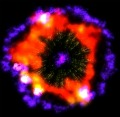|
The gas giant that will "scatter" you away
|
|
| ElectricalEel | Date: Friday, 10.04.2015, 11:07 | Message # 1 |
 Space Tourist
Group: Users
 Kuwait
Kuwait
Messages: 33
Status: Offline
| look how many moons this monster of a planet has,and its not even all that big nor its gravity strong enough to catch this much moons
529 moons
thats like having an entire asteroid belt for a moon system
this might be a bug infact,would love anyone to tell me if it is
the only explanation is that early in its formation it moved through the asteroid belt and scattered them all,but somehow managed to catch a whole lot of them somehow (i dont know planet dynamics)
|
| |
| |
| Nol | Date: Friday, 10.04.2015, 11:15 | Message # 2 |
 Space Pilot
Group: Users
 Germany
Germany
Messages: 97
Status: Offline
| You can find Planets like these pretty often. The strangest Thing here is probably the Fact that some Moons orbit the Planet in more than 0.2 AU distance.
"Eins - Hier kommt die Sonne
Zwei - Hier kommt die Sonne
Drei - Sie ist der hellste Stern von allen
Vier - Hier kommt die Sonne"
-Rammstein, Sonne, Mutter, 2001
|
| |
| |
| ElectricalEel | Date: Friday, 10.04.2015, 11:19 | Message # 3 |
 Space Tourist
Group: Users
 Kuwait
Kuwait
Messages: 33
Status: Offline
| Quote Nol (  ) You can find Planets like these pretty often. The strangest Thing here is probably the Fact that some Moons orbit the Planet in more than 0.2 AU distance.
so that many moons is normal but the moons orbiting further than 0.2 au distance arent normal and probably a bug?
|
| |
| |
| Nol | Date: Friday, 10.04.2015, 11:25 | Message # 4 |
 Space Pilot
Group: Users
 Germany
Germany
Messages: 97
Status: Offline
| ElectricalEel, Moons in that Distance are probably a Thing in the real Universe, but rare.
As an Addition to my previous Answer: Here's a Gas Giant with even less Gravity and 678 Moons orbiting it:

EDIT: Jesus, why are there so many Gas Giants with Moons that orbit them THAT far away?

"Eins - Hier kommt die Sonne
Zwei - Hier kommt die Sonne
Drei - Sie ist der hellste Stern von allen
Vier - Hier kommt die Sonne"
-Rammstein, Sonne, Mutter, 2001
Edited by Nol - Friday, 10.04.2015, 11:28 |
| |
| |
| ElectricalEel | Date: Friday, 10.04.2015, 11:31 | Message # 5 |
 Space Tourist
Group: Users
 Kuwait
Kuwait
Messages: 33
Status: Offline
| this is just comical,you would think some of these moons would collide together at one point to form a bigger moon but no
|
| |
| |
| Nol | Date: Friday, 10.04.2015, 11:34 | Message # 6 |
 Space Pilot
Group: Users
 Germany
Germany
Messages: 97
Status: Offline
| ElectricalEel, It's even more comical when you think about this: You have a Gas Giant with a "meh" Gravity and then you find a Moon that orbits the Planet in 11 Times the Distance of Earth to the Sun. How is that possible? Gravity? Aliens? Illuminati? Half Life 3? It's ridiculous!
To the Moon-Collisions: Well, since they orbit the Planet in THAT Distance, they are probably a few Million Kilometers away from each other, so I doubt that they collide so easy with each other.
"Eins - Hier kommt die Sonne
Zwei - Hier kommt die Sonne
Drei - Sie ist der hellste Stern von allen
Vier - Hier kommt die Sonne"
-Rammstein, Sonne, Mutter, 2001
Edited by Nol - Friday, 10.04.2015, 11:45 |
| |
| |
| ElectricalEel | Date: Friday, 10.04.2015, 11:59 | Message # 7 |
 Space Tourist
Group: Users
 Kuwait
Kuwait
Messages: 33
Status: Offline
| Quote Nol (  ) How is that possible? Gravity? Aliens? Illuminati? Half Life 3? It's ridiculous!
probably aliens
|
| |
| |
| apenpaap | Date: Friday, 10.04.2015, 12:23 | Message # 8 |
 World Builder
Group: Users
 Antarctica
Antarctica
Messages: 1063
Status: Offline
| The mass of a planet isn't the only factor that influences the size of its Hill-sphere (the distance a moon can orbit it). Its distance to its sun is also very relevant; the farther away the sun, the larger an area is dominated by the planet's gravity. As a result, it's Neptune which has the furthest moon in our Solar System, not Jupiter (Neso, which reaches a distance of half a AU from Neptune and takes 27 years to orbit).
I occasionally stream at http://www.twitch.tv/magistermystax. Sometimes SE, sometimes other games.
|
| |
| |
| Quontex | Date: Friday, 10.04.2015, 14:31 | Message # 9 |
 Explorer
Group: Users
 Australia
Australia
Messages: 155
Status: Offline
| Actually I'd like to also add that debris rings can apparently also contribute. Here I have a planet that is an example of that.


|
| |
| |
| Dodecahedron | Date: Friday, 10.04.2015, 16:00 | Message # 10 |
 Astronaut
Group: Users
 United States
United States
Messages: 58
Status: Offline
| This planet has 1,019 moons.
RS 6787-35-8-6788026-823 6
Here's how to find them: http://www.reddit.com/r....re_than
" What compromises in precision should scientists make in the name of tradition, sentiment, and good public relations?"
None
|
| |
| |